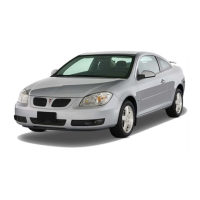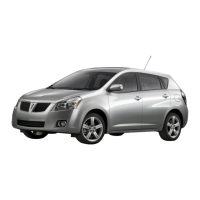
Do you have a question about the Pontiac 2009 Montana SV6 and is the answer not in the manual?
| Brand | Pontiac |
|---|---|
| Model | 2009 Montana SV6 |
| Category | Automobile |
| Language | English |
Explains proper safety belt usage and what not to do with them.
Information for adults on wearing safety belts correctly and child restraint considerations.
Instructions on how to wear a lap-shoulder belt properly.
Guidelines for older children who have outgrown booster seats to use vehicle safety belts.
CAUTION about serious injury or strangulation from shoulder belts around necks.
Explains rear-facing infant seats, forward-facing child seats, and booster seats.
CAUTION about child injury if restraint is not properly secured.
Recommends rear seating for children and child restraints due to airbag risks.
Explains the LATCH system for easier child restraint installation.
CAUTION about child injury if restraint is not attached to anchors.
Instructions for securing child restraints in rear seats using LATCH or safety belts.
Information about airbags and safer rear seat placement for child restraints.
Identifies the location of frontal airbags in the steering wheel and instrument panel.
Explains factors determining frontal airbag deployment in crashes.
Explains the system that detects occupants and enables/disables front airbags.
CAUTION about potential airbag inflation during improper service and avoiding yellow connectors.
How to check safety belts, buckles, retractors, and anchorages.
CAUTION that crash-damaged restraint systems may not protect properly.
Details functions like Remote Vehicle Start, Lock, and Unlock.
CAUTION about danger of unlocked doors and how to lock/unlock doors with key or transmitter.
CAUTION about leaving children or pets unattended in the vehicle.
Ways to open and close power sliding doors using switches or the RKE transmitter.
CAUTION about children operating power windows and using the lockout button.
Information on the PASS-Key® III theft-deterrent system's operation.
Procedure for programming a new key for the PASS-Key® III system.
Guidelines for breaking in a new vehicle for optimal performance and longevity.
Instructions for starting the engine and the Computer-Controlled Cranking System.
CAUTION about the dangers of exiting the vehicle if not in PARK with the parking brake set.
CAUTION about the danger of exiting the vehicle if not properly in PARK.
CAUTION about parking over things that can burn and cause fires.
CAUTION about carbon monoxide (CO) in exhaust gases and how it can enter the vehicle.
CAUTION about idling in enclosed areas and safe practices for parking with the engine running.
CAUTION that URPA does not replace driver vision and cannot detect certain objects.
Instructions for programming Universal Home Remote buttons.
Steps for programming garage door openers and gate operators.
How to control wipers using the multifunction lever: Mist, Off, Delay, Low Speed, High Speed.
CAUTION about using cruise control on winding roads or slippery surfaces.
Explanation of system controls for heating, cooling, and ventilation.
System controls for heating, cooling, and ventilation for the vehicle.
Explanation of how warning lights and gages signal vehicle problems.
Information on safety belt reminder lights and passenger reminders.
CAUTION if the airbag readiness light stays on, indicating a potential system malfunction.
CAUTION if the airbag readiness light comes on and stays on, indicating a system problem.
When the brake system warning light comes on and what it signifies.
CAUTION if the brake system warning light is on, indicating potential braking issues.
What the tire pressure light indicates and when it flashes.
Notice about driving with the check engine light on and potential warranty issues.
How messages are displayed on the DIC and how to acknowledge them.
Items displayed when pressing the Information button: Odometer, Trip A/B, Time Elapsed, Average Speed.
How the DIC displays tire pressure and what to do if low pressure is detected.
How to program certain features to a preferred setting for up to two drivers.
How messages are displayed on the DIC and how to acknowledge them.
Information on playing MP3 CD-R discs and MP3 format guidelines.
How to connect and use external audio devices via the auxiliary input jack.
Explanation of DVD player buttons for playback, navigation, and control.
How to use the OSD menu to select video format, language, and display settings.
Defensive driving means expecting the unexpected and wearing safety belts.
CAUTION about the dangers of drinking and driving and its effects on judgment.
Explanation of perception and reaction time in braking and stopping distances.
How ABS helps prevent braking skids and allows steering during hard braking.
How TCS limits wheel spin and what the TRACTION CONTROL ACTIVE message means.
How StabiliTrak combines systems to help maintain directional control.
What happens when control systems do not have enough friction and what to do in an emergency.
Types of skids and how to handle them, including traction control's role.
Explanation of hydroplaning and the advice to slow down on wet roads.
CAUTION about the dangers of coasting downhill with the ignition off or in Neutral.
Advice for driving carefully on snow or ice to maintain traction.
CAUTION about snow trapping exhaust gases containing carbon monoxide (CO).
Method for freeing a stuck vehicle by shifting between gears.
CAUTION about not loading the vehicle heavier than the Gross Vehicle Weight Rating (GVWR).
Steps for determining the correct load limit and calculating cargo capacity.
CAUTION about the dangers of putting items inside the vehicle that can strike people.
Recommends using a platform or flatbed trailer for towing the vehicle.
CAUTION about losing control when pulling a trailer without correct equipment.
Important points for trailering, including legal restrictions and using a sway control.
How trailer weight calculation depends on various factors and vehicle equipment.
CAUTION about exhaust gases collecting at the rear of the vehicle when the liftgate is open.
CAUTION about overheating brakes if not shifting to a lower gear on steep downgrades.
CAUTION about the dangers of parking on hills and the steps to secure the vehicle.
How non-dealer accessories can affect vehicle performance, safety, and warranty.
Importance of using recommended fuel, TOP TIER Detergent Gasoline, and VIN code for engine identification.
CAUTION about fuel vapor ignition and safe refueling practices.
CAUTION about static electricity igniting fuel vapor and safe dispensing practices.
CAUTION about electric fans starting unexpectedly and injuring personnel.
How to check the engine oil level using the dipstick.
CAUTION about not adding too much oil to prevent engine damage.
How the system calculates oil life based on engine use, not mileage.
Notice about too much or too little fluid causing transmission damage or fire.
Instructions for checking transmission fluid level, including warming the vehicle.
CAUTION about electric engine cooling fans and hot engine parts.
CAUTION about adding only plain water to the cooling system.
How to check coolant level in the recovery tank and add coolant.
Indicators of engine overheating, including the temperature gauge and DIC message.
CAUTION about spilling brake fluid on the engine and the causes of low brake fluid level.
CAUTION about spilling brake fluid on the engine and the causes of low brake fluid level.
CAUTION that brake wear warning sound indicates brakes may not work well.
CAUTION about battery acid and explosive gas hazards.
CAUTION about battery hazards and the risks of improper jump starting.
Instructions for inspecting and replacing windshield wiper blades.
CAUTION about poorly maintained or improperly used tires being dangerous.
Importance of correct air pressure and consequences of under-inflation or over-inflation.
CAUTION about the strain on tires from high-speed driving and the need for proper inflation.
How TPMS uses sensors to check tire pressure and warns of low pressure.
Reasons for TPMS malfunction light and DIC messages, including tire replacement.
How to match TPMS sensors to tire/wheel positions after rotation or replacement.
Recommendations for regularly inspecting tires and rotating them for uniform wear.
CAUTION about adding different sized wheels and tires affecting vehicle performance and safety.
CAUTION about using wrong replacement wheels or bolts causing danger.
CAUTION about tire chain clearance and potential damage or injury.
How to use the accessory inflator to inflate tires and other items.
CAUTION about the danger of lifting a vehicle with a jack without proper safety equipment.
CAUTION about the vehicle potentially slipping off the jack during tire changes.
CAUTION about rust or dirt on wheels affecting nut tightness.
CAUTION about incorrectly tightened wheel nuts causing accidents.
CAUTION about storing a jack, tire, or equipment in the passenger compartment causing injury.
CAUTION about storing the spare tire with the valve stem pointing down.
Notice that failure to follow scheduled maintenance may void the vehicle warranty.
How the CHANGE OIL SOON message indicates required service and alternates between Maintenance I and II.
CAUTION about the vehicle potentially moving if not properly in PARK.
Specific fluid/lubricant recommendations for various vehicle systems.
Steps to resolve concerns: discuss with dealership management, then contact Customer Assistance.
Program offering transportation options during warranty repairs.
How to inform NHTSA and General Motors about safety defects.
How to inform NHTSA and General Motors about safety defects.
How to notify Transport Canada and General Motors of Canada about safety defects.
Information about sophisticated computer modules recording vehicle performance and driver data.












